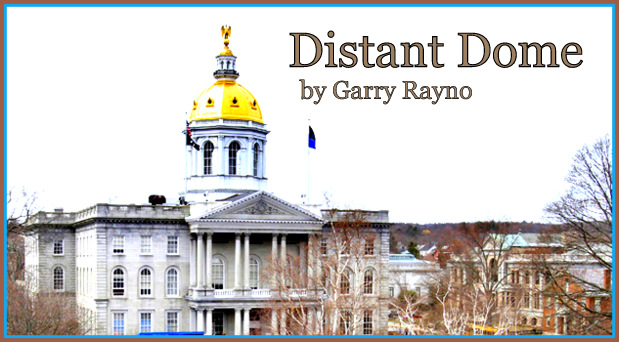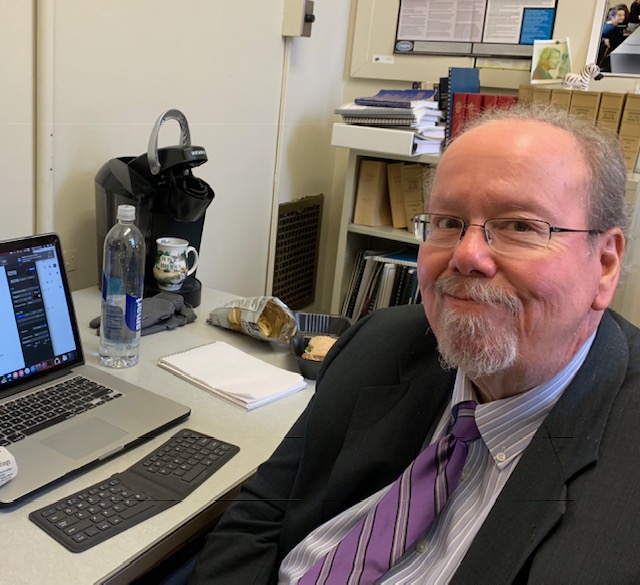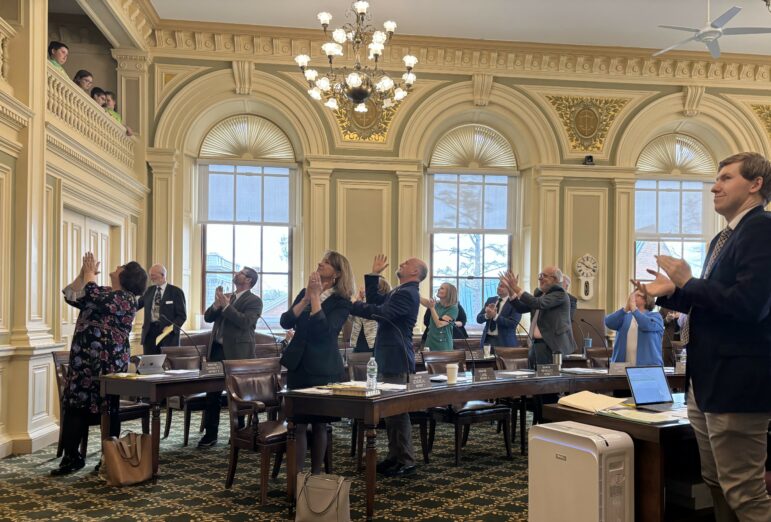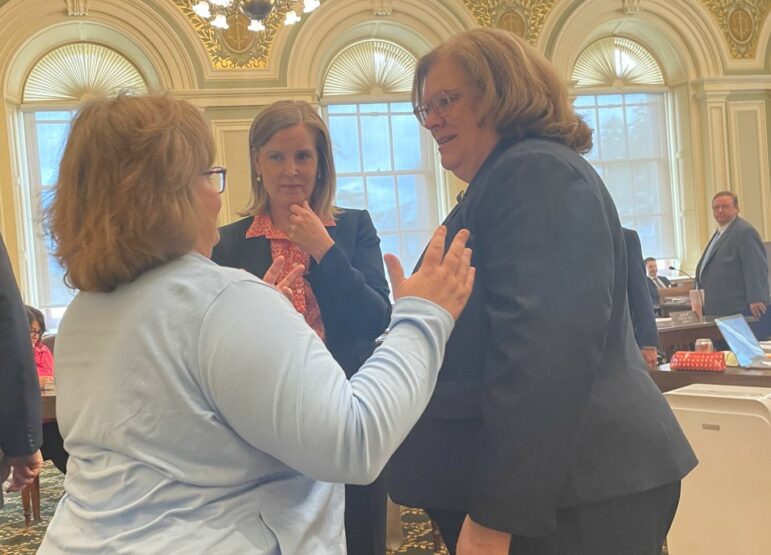
By GARRY RAYNO, InDepthNH.org
CONCORD — The Legislature is about to enter the new normal for the near future if not a new world.
The Senate and House leadership announced the resurrection of the 2020 session late last week. The session came to a halt in mid-March after the coronavirus pandemic began to infect Granite Staters.
The House session ended in a marathon, all-night slog through nearly 100 bills, while the Senate finished a day earlier.
Next month, for the first time since the Civil War, the House and Senate will meet outside their historic chambers to ensure a safe environment for lawmakers, staff and the public.
The 24-member Senate will meet in the 400-seat House of Representatives which should provide more than ample room for social distancing.
The House will meet in the Whittemore Center on the deserted University of New Hampshire’s Durham campus. The center is home to UNH’s hockey team, with many speculating a thrown fish would connote the first bill’s passage.
“While some legislative activities, including Committee and Commission meetings, have resumed work remotely, we understand it is important for the Legislature to resume session to complete the work that the people of New Hampshire elected us to do as well as provide important checks and balances to the state government during this crisis,” said Senate President Donna Soucy, D-Manchester, and House Speaker Stephen Shurtleff, D-Concord in a joint statement. “We are committed to returning in a manner that ensures public access to the process and above all adheres to public health recommendations, which is why when the House and Senate come back into session next month we will be meeting outside of our respective chambers for the first time since the Civil War.”
The first sessions of the House and Senate are expected at the beginning of June. Deadlines have already been altered when lawmakers approved a rule change in March before sessions were suspended. The change allows the 2020 session to continue past the usual second-year deadline at the end of May, which traditionally allows House and Senate members ample time to begin campaigning for reelection.
No Mention
What has not been addressed to date, but has to be very soon, is what to do about the state’s $6.4 billion fiscal 2019-2020 operating budget ending June 30.
It is no secret state revenues are expected to be well below estimates by several hundred million dollars when the fiscal year ends.
The other unknown is how much additional spending has been or will be spent on the COVID-19 pandemic.
The revenue shortfall and the additional spending will mean a significant adjustment will have to be made in the operating budget as the fiscal year winds down.
The federal coronavirus packages approved to date, forbid using the money to offset revenue shortfalls for states or cities or towns.
The latest $3 trillion package approved by the House last week would provide funds to help with the shortfalls, but neither the Senate nor the White House are on board in its current composition.
Unless there is a quick federal agreement, budget adjustments are coming soon, but where?
Loose Change
When Gov. Chris Sununu established his $50 million Health System Relief Fund March 19, he used money earmarked for projects yet to be implemented to fill the coffer.
The transfers included $8.75 million for a new secure psychiatric unit on the State Hospital grounds, $4 million from a loan forgiveness program to encourage primary care physicians to practice in rural areas, $2 million to help low-income seniors with prescription drugs costs once they hit the “donut hole,” $1.7 million for a homeless shelter program, $750,000 for a congregate living program, and $100,000 for a foster grandparents program.
Recently the director of the Governor’s Office for Emergency Relief and Recovery, Jerry Little, said the money had been returned to the original accounts when the state gained access to its $1.25 billion allotment under the CARES Act.
Oversight of the fund was also transferred from the Department of Health and Human Services into the GOFERR at the same time.
If that money was grabbed once, why not use it again to help fill the looming deficit? There was little blowback the first time, so politicians will say why not again, although several of those programs are pet projects of key legislative budget writers.
Money Pot
One of the techniques often used by lawmakers to balance out-of-balance budgets is across-the-board cuts.
A 1 or 2 percent reduction in appropriations can generate a lot of savings but is like using an ax to trim a tenderloin steak. While budgets can be reduced, no care is taken to ensure no significant harm is done or to impact areas needing additional money.
Government is not market driven. Government spending is needed most when there is an economic downturn which reduces revenues.
When the economy is humming, revenues are robust and the demand for services is lower, investments like new equipment and buildings are possible as is filling the state’s savings account.
The real problem with across-the-board cuts is they impact small agencies much more than they do larger ones like Health and Human Services which accounts for more than 40 percent of state spending.
There are plenty of places to find money in Health and Human Services but not so for the board of medicine where a cut means laying off a critical employee.
But given the short time left in the fiscal year, this is a very likely scenario.
Rainy Day Fund
State law says the rainy day fund cannot be used unless revenues are lower than anticipated and there is a deficit, which is the situation today. However, bond rating agencies hate to see the rainy day fund drained.
Draining the fund lowers the state’s bond rating, which hikes borrowing costs for the state and for cities, towns and counties.
On the other hand, borrowing money today is a lot cheaper than it was before the last great recession in 2008.
In reality, lawmakers will see the money just sitting there and the argument will be to use the fund before cutting services to people, particularly those affected by the COVID-19 pandemic’s economy downturn.
Downshifting
Another tried and true technique for state lawmakers is downshifting costs to communities. During the last great recession, the state ended revenue sharing, and contributing to the retirement fund for municipal, school and county workers, and they cut support to the university and community college systems in half downshifting costs to families.
There is concern the state will do that this time as well.
This budget contains new money to help the most needy schools and restores some revenue sharing.
The education capacity aid is included in the 2020-2021 budget, but that money has already been spent as has the $20 million in revenue sharing as school districts, cities and towns have included that money in budgets already approved by most communities and school districts.
Cities and towns expect greater delinquency in property tax payments the first of July because people have lost their jobs and businesses have been shuttered for two months.
The Legislative Advisory Committee to GOFERR suggested any business receiving help from the CARES Act money would have to pay their property taxes as a way of softening some of the blow to cities and towns.
But when Sununu announced his $400 million Main Street Relief Fund Friday, he said he wants to give business owners flexibility in determining which bills to pay.
That is not the message cities and towns want to hear as they struggle to balance their books just as the state is.
The message instead may be “watch out below.”
Garry Rayno may be reached at garry.rayno@yahoo.com.
Distant Dome by veteran journalist Garry Rayno explores a broader perspective on the State House and state happenings for InDepthNH.org. Over his three-decade career, Rayno covered the NH State House for the New Hampshire Union Leader and Foster’s Daily Democrat. During his career, his coverage spanned the news spectrum, from local planning, school and select boards, to national issues such as electric industry deregulation and Presidential primaries. Rayno lives with his wife Carolyn in New London.
InDepthNH.org is New Hampshire’s only nonprofit, online news outlet dedicated to reporting ethical, unbiased news and diverse opinions and columns.





